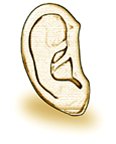|
Otitis media is an inflammation of the inner ear characterized
by fluid buildup. The condition is one of the most common
acute respiratory
conditions managed in primary care, most frequently affecting
children. In fact, otitis media ranks second to the common
cold as the most common health problem in children.
Despite its prevalence, treatment options for otitis media
remain controversial. Most children are prescribed antibiotics,
although considerable evidence suggests that the results are
minimal at best. While antibiotics may have important benefits,
there is little evidence suggesting that these prescriptions
create positive differences in alleviating pain and distress
associated with otitis media.
 A study in the British Medical Journal investigated
the utility of a 72-hour "wait-and-see" approach vs. antibiotics
in managing otitis media in 315 children six months to 10
years of age. Children were randomly assigned to one of two
protocols: antibiotics prescribed immediately, and prescriptions
withheld for 72 hours. Results showed only minimal differences
between the two groups, with no significant difference in
school absence, pain or distress. A study in the British Medical Journal investigated
the utility of a 72-hour "wait-and-see" approach vs. antibiotics
in managing otitis media in 315 children six months to 10
years of age. Children were randomly assigned to one of two
protocols: antibiotics prescribed immediately, and prescriptions
withheld for 72 hours. Results showed only minimal differences
between the two groups, with no significant difference in
school absence, pain or distress.
It's important to note that waiting for 72 hours while monitoring
symptoms is safe, but a blanket approach of nonintervention
may have dangers. However, these findings add to the considerable
evidence espousing the value of conservative care in achieving
positive health benefits. For more information on pediatric
health, talk to your doctor and visit https://www.chiroweb.com/tyh/pediatrics.html.
Reference:
Little P, Gould C, Williamson I, et al. Pragmatic randomized
controlled trial of two prescribing strategies for childhood
acute otitis media. British Medical Journal February
2001:322, pp336-342.
|



